Cow ghee is more than just a cooking ingredient; if you’ve ever tasted its divine richness, you know it’s a game-changer. Even though this golden elixir has been a staple of Indian food for many years, many people still don’t know how to maximise its benefits. No matter how experienced you are, you probably want to know how to add ghee to regular dishes without going overboard. This post will discuss delectable recipes that highlight the complete flavour and health advantages of cow ghee. These dishes, both sweet and savoury, will demonstrate how simple it is to incorporate this nutrient-dense marvel into your cooking. Do you want to improve your meals? Now let’s get started!
Table of Contents
The Magic of Cow Ghee: Why It’s Worth the Hype
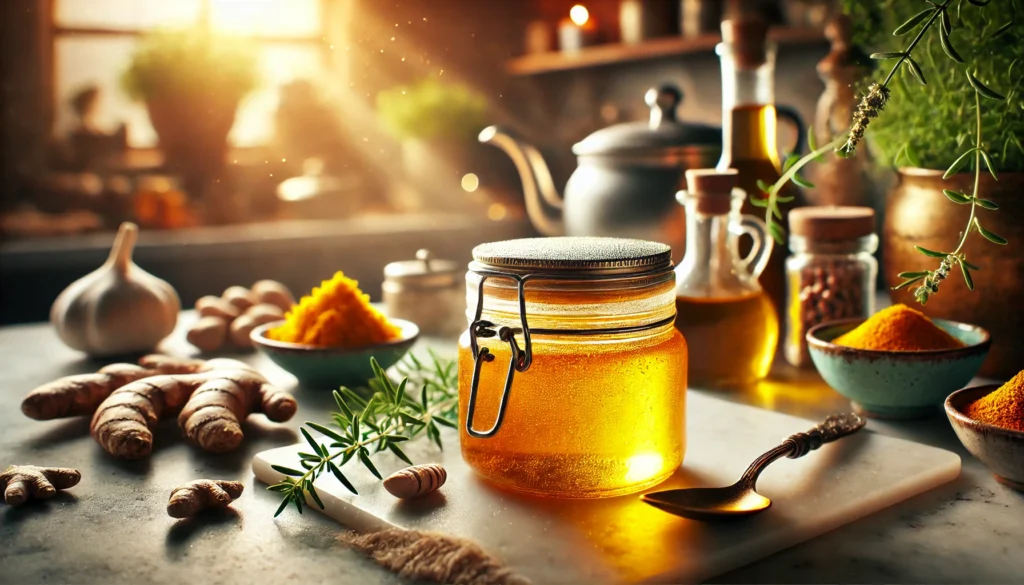
- What is Cow Ghee?
Cow ghee is more than just a cooking fat—it’s a revered ingredient with deep roots in South Asian culture. This golden, clarified butter is made by simmering unsalted butter to remove the water content and milk solids, leaving behind pure, rich fat. The process of making ghee dates back thousands of years, originating in ancient India where it was valued not only for its culinary uses but also for its medicinal properties. Unlike regular butter, cow ghee is free of lactose and casein, making it a safe option for those with dairy sensitivities.
- Difference Between Cow Ghee and Regular Butter or Other Oils
While both butter and ghee are derived from dairy, the key difference lies in their preparation. Butter retains moisture and milk solids, which can make it burn at lower temperatures. Ghee, on the other hand, has been cooked and clarified, resulting in a higher smoke point—around 485°F (250°C), compared to butter’s 350°F (175°C). This makes ghee ideal for cooking at high temperatures without losing flavor or nutritional value. Moreover, ghee is rich in butyrate, a short-chain fatty acid, which offers a host of health benefits that regular butter simply cannot match.
- Health Benefits of Cow Ghee
Cow ghee is a powerhouse of nutrients. It’s packed with vitamins A, E, and K, all of which are essential for maintaining healthy skin, improving eyesight, and supporting bone health. Ghee is also known for its high content of healthy fats, which provide a long-lasting source of energy and support cell function. But perhaps one of its most impressive qualities is its antioxidant-rich composition, which helps combat inflammation and promotes overall wellness.
Digestively, ghee is highly beneficial as well. It has been used for centuries in Ayurvedic medicine to improve gut health by lubricating the intestines, aiding digestion, and reducing bloating. Additionally, ghee’s rich composition supports the immune system by delivering essential nutrients directly to the body’s cells, improving overall health.
- Why Cow Ghee is Ideal for Cooking
When it comes to cooking, cow ghee is truly a standout. Its high smoke point means it won’t break down into harmful compounds like some vegetable oils, ensuring that the flavors you’re infusing into your dish remain intact. Plus, ghee’s versatility shines through in both savory and sweet dishes, enhancing everything from curries to desserts with its rich, nutty flavor. With ghee, you can fry, sauté, roast, or even drizzle it over your dishes to add a luxurious finish.
How to Choose the Best Cow Ghee
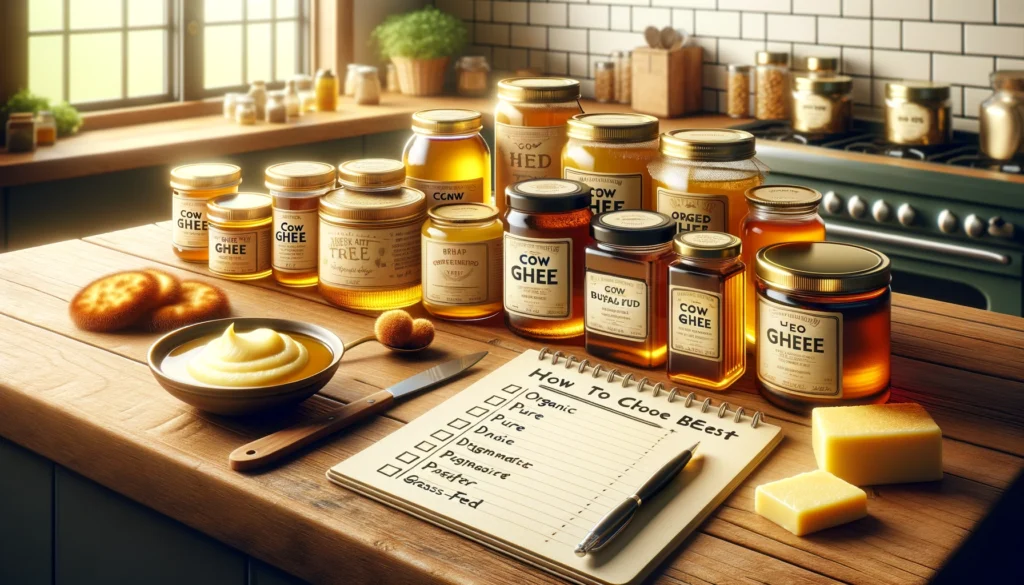
- What to Look for in High-Quality Ghee
Choosing the best cow ghee can make a significant difference in both taste and health benefits. When shopping for ghee, look for products labeled as grass-fed and organic. Grass-fed cows produce ghee that’s richer in omega-3 fatty acids and CLA (conjugated linoleic acid), both of which contribute to heart health and weight management. Ideally, choose ghee that’s made from pure cow’s milk, free from any additives or preservatives.
Signs of quality include a smooth texture, a rich golden color, and a slightly nutty, aromatic fragrance. Avoid ghee that appears overly hard or greasy, as this may indicate poor quality or improper storage.
- How to Store Your Ghee
Ghee has a long shelf life due to the absence of moisture. It can be stored at room temperature for up to three months, but for extended storage, keep it in the refrigerator. Be sure to store it in an airtight container to prevent exposure to air, which can cause it to spoil. Ghee’s natural preservatives ensure it won’t go rancid quickly, making it a staple you can rely on for months.
Savory Recipes That Benefit from Cow Ghee
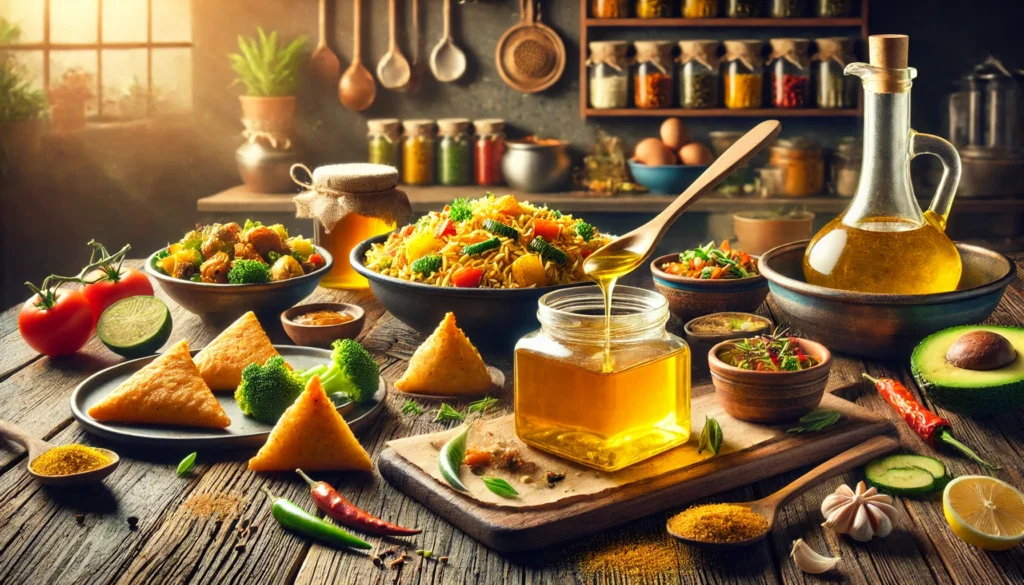
- Aromatic Ghee Rice
Aromatic Ghee Rice is a simple yet flavorful dish that highlights the richness of ghee. To make it, heat a tablespoon of ghee in a pan, add cumin seeds, cinnamon sticks, and a bay leaf, letting them sizzle in the hot ghee. Once fragrant, toss in your rice and sauté it in the ghee for a few minutes, allowing it to absorb all those flavors. Add water and cook the rice until tender. The result? Rice that’s fragrant, fluffy, and enriched with the nutty flavor of ghee.
- Ghee-Powered Dal Tadka
Dal Tadka is a comforting, hearty dish that pairs perfectly with the richness of ghee. Begin by boiling your lentils (dal) until soft, then prepare the tempering (tadka) by heating ghee in a small pan. Add mustard seeds, cumin, garlic, ginger, and dried red chilies to the ghee and sauté until golden and fragrant. Pour this tempering over the cooked dal, and stir well to incorporate the rich flavors. The ghee imparts a depth of flavor and smooth texture, making the dal irresistibly creamy and delicious.
- Ghee-Infused Vegetables Stir Fry
There’s no better way to bring out the natural flavors of seasonal vegetables than by sautéing them in ghee. Heat a tablespoon of ghee in a pan, then toss in a medley of your favorite vegetables—think bell peppers, zucchini, carrots, and green beans. Add a pinch of turmeric, cumin, and coriander for spice, and stir-fry until the vegetables are tender and slightly caramelized. The ghee’s rich, nutty flavor complements the spices and vegetables perfectly, creating a dish that’s both nutritious and satisfying.
- Ghee Paratha
A classic Indian flatbread, Paratha, becomes even more indulgent when made with ghee. To create soft, flaky parathas, knead your dough with a tablespoon of ghee for extra richness. Roll the dough into flat discs, then cook them on a hot griddle, brushing each side with a bit more ghee to achieve that perfect golden crust. The result is a paratha that’s tender, flaky, and irresistibly delicious, perfect for dipping into curries or enjoying on its own.
Sweet Treats That Shine with Cow Ghee
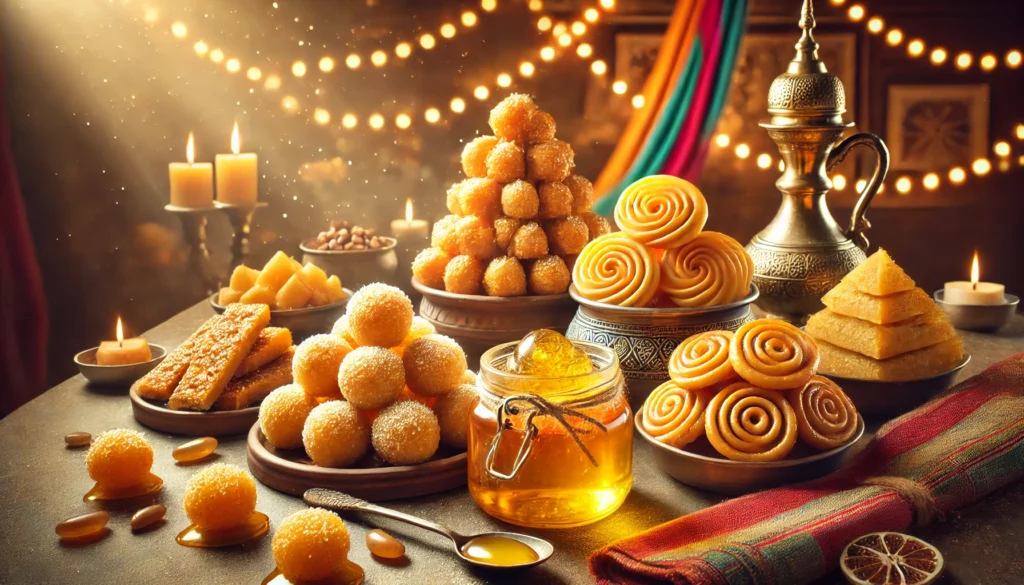
- Ghee Halwa (Carrot or Bottle Gourd)
A rich, indulgent dessert, Ghee Halwa is made by simmering grated carrots or bottle gourd in ghee until they become soft and sweet. As the vegetables cook, they absorb the ghee, which helps bring out their natural sweetness while adding a luxurious texture. Sweetened with jaggery and flavored with cardamom, this dessert is a guilt-free treat that’s both nourishing and satisfying.
- Ghee Laddoos
Laddoos are a traditional Indian sweet made from besan (chickpea flour) and ghee. To make these melt-in-your-mouth treats, roast the besan in ghee until golden and fragrant, then mix in jaggery and cardamom. Roll the mixture into small balls and let them cool. The ghee gives the laddoos their delicate texture and rich flavor, making them a favorite during festivals and celebrations.
- Ghee-Infused Rice Pudding (Kheer)
Kheer, or rice pudding, is a beloved dessert that reaches new heights when made with ghee. Begin by simmering rice in milk, and once the rice is soft, stir in a spoonful of ghee. This addition makes the pudding rich and creamy, while also adding a subtle, nutty flavor that perfectly balances the sweetness of the milk and sugar. Garnish with chopped nuts and a dash of cardamom for a delightful finish.
Drinks and Smoothies with a Ghee Twist
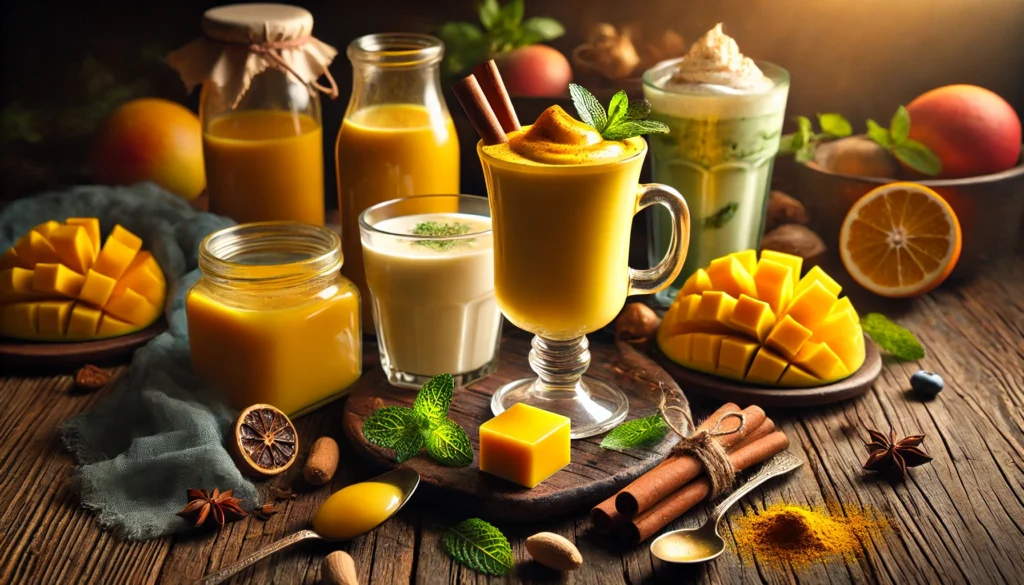
- Golden Milk (Turmeric Latte)
Golden Milk, also known as turmeric latte, is a nourishing drink that’s both comforting and health-boosting. To make it, warm a cup of milk (or a milk alternative), then stir in a teaspoon of turmeric, a pinch of black pepper, and a spoonful of ghee. The ghee helps dissolve the fat-soluble compounds in turmeric, improving absorption and enhancing the drink’s anti-inflammatory properties. Sip it slowly to enjoy its warming effects and nutrient-packed goodness.
- Ghee-Infused Smoothies
Adding ghee to smoothies might sound unusual, but it’s a game-changer. The healthy fats in ghee help with nutrient absorption, making your smoothie even more nourishing. Blend ghee with fruits like bananas, berries, or mangoes, along with nuts and seeds for added protein. This creamy, energizing smoothie is perfect for breakfast or a midday pick-me-up.
Tips and Tricks for Cooking with Cow Ghee
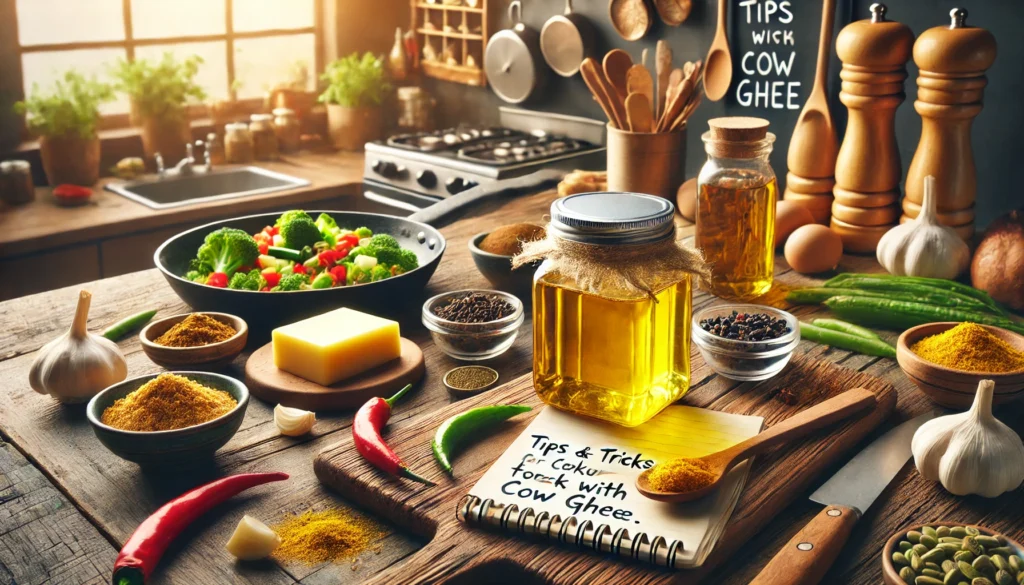
- How Much Ghee to Use
When cooking with ghee, less is often more. Due to its rich flavor and texture, you only need a small amount to make a big impact. A tablespoon or two is usually enough to flavor a dish, and since ghee is calorie-dense, it’s best to use it in moderation.
- How to Bring Out the Best in Ghee
To get the most out of ghee, pay attention to the cooking temperature. Ghee should be heated gently to preserve its nutrients and flavor. Avoid overheating it, as this can lead to a bitter taste. Additionally, adding ghee at the end of cooking, such as for finishing a curry or drizzling over rice, will allow the full flavor to shine.
- Substituting Other Fats with Ghee
If you’re looking to make healthier choices, ghee is an excellent alternative to butter, oil, or cream. It can replace butter in baking, oil in sautéing, or even cream in soups for added richness without compromising on taste or texture.
The Final Word: Enjoy the Richness of Cow Ghee Every Day
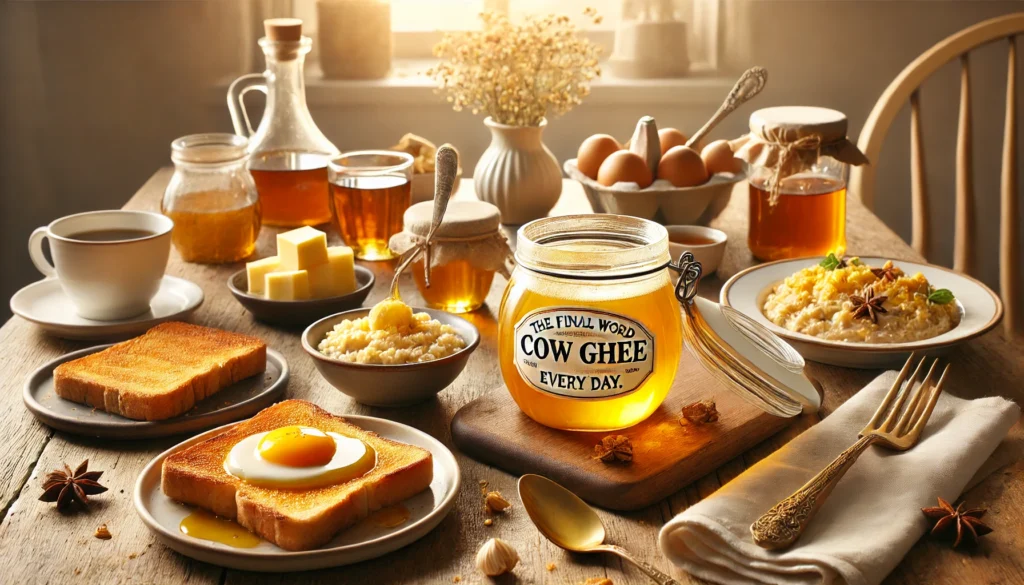
- Incorporating Ghee into Your Daily Routine
Adding ghee to your daily meals is a simple way to boost your nutrition. Try starting your day with ghee on your toast or mixing it into your morning oatmeal. You can also drizzle it over vegetables, use it to sauté meats, or even add it to your favorite soups and curries for a rich, indulgent finish.
- A Word on Moderation
While ghee is a healthy fat, it’s still important to consume it in moderation. A little goes a long way in terms of flavor and nutritional benefits. As part of a balanced diet, ghee can enhance your meals without tipping the scale.
Conclusion
Cow ghee is not just a traditional cooking fat, it’s a superfood that brings both flavor and nutrition to your table. Whether you’re cooking savory dishes, baking sweet treats, or sipping on a nourishing drink, ghee can transform your meals. With its high smoke point, rich flavor, and impressive health benefits, it’s no wonder that cow ghee is making a big comeback in kitchens around the world. So, go ahead—experiment with these recipes, and enjoy the richness of ghee in every bite!
FAQs – Frequently Asked Questions
-
What is the difference between cow ghee and regular butter?
The primary difference between cow ghee and regular butter lies in their composition and preparation. While both are dairy products, ghee is made by simmering butter to remove the milk solids and water, leaving behind pure fat. This makes ghee lactose-free and free of casein, which makes it suitable for individuals with dairy sensitivities. Additionally, ghee has a higher smoke point (485°F or 250°C) compared to butter (350°F or 175°C), meaning it’s better suited for high-temperature cooking without breaking down and losing flavor. Ghee also contains more healthy fats and antioxidants, offering greater nutritional benefits than regular butter.
-
What are the health benefits of consuming cow ghee?
Cow ghee is packed with several health benefits, making it a valuable addition to your diet. It is rich in vitamins A, E, and K, which support eye health, skin health, and bone health. Ghee is also a good source of healthy fats, including omega-3 fatty acids and butyrate, which promote heart health and improve gut function. Additionally, ghee has anti-inflammatory properties, supports the immune system, and helps with digestion by lubricating the intestines. It’s known to improve nutrient absorption, making it an excellent fat for boosting overall health when consumed in moderation.
-
How should I store cow ghee to keep it fresh?
Cow ghee has a long shelf life and can be stored at room temperature for up to three months. To keep it fresh, store your ghee in an airtight container to prevent exposure to moisture and air, which can cause it to spoil. For longer storage, you can refrigerate ghee, which will extend its shelf life significantly. Since ghee doesn’t contain water, it doesn’t require refrigeration, but doing so can help preserve its flavor and nutritional quality for longer periods.
-
Can I substitute cow ghee for other cooking oils in recipes?
Yes, cow ghee can be substituted for other cooking oils in most recipes, and it can often enhance the flavor of the dish. Ghee can replace vegetable oil, olive oil, butter, or even cream in many savory and sweet recipes. It works especially well for high-heat cooking methods like frying, sautéing, and roasting, thanks to its high smoke point. Additionally, ghee can be used in baking for a more indulgent flavor or drizzled over cooked vegetables, grains, or even popcorn for a rich, nutty taste. Just be mindful to use it in moderation, as ghee is calorie-dense.
-
Is it safe to cook with ghee every day?
Yes, cooking with ghee every day can be part of a healthy diet, provided it’s consumed in moderation. Ghee is a nutrient-dense fat that offers a wide range of health benefits, but like any fat, it should be used mindfully. A small amount (1-2 tablespoons) can provide essential fatty acids, vitamins, and antioxidants without compromising your health. It’s important to balance ghee with other healthy fats, such as those from nuts, seeds, and avocados, to ensure your diet remains well-rounded and supports overall wellness. For most people, incorporating ghee daily as part of a balanced diet is both safe and beneficial.

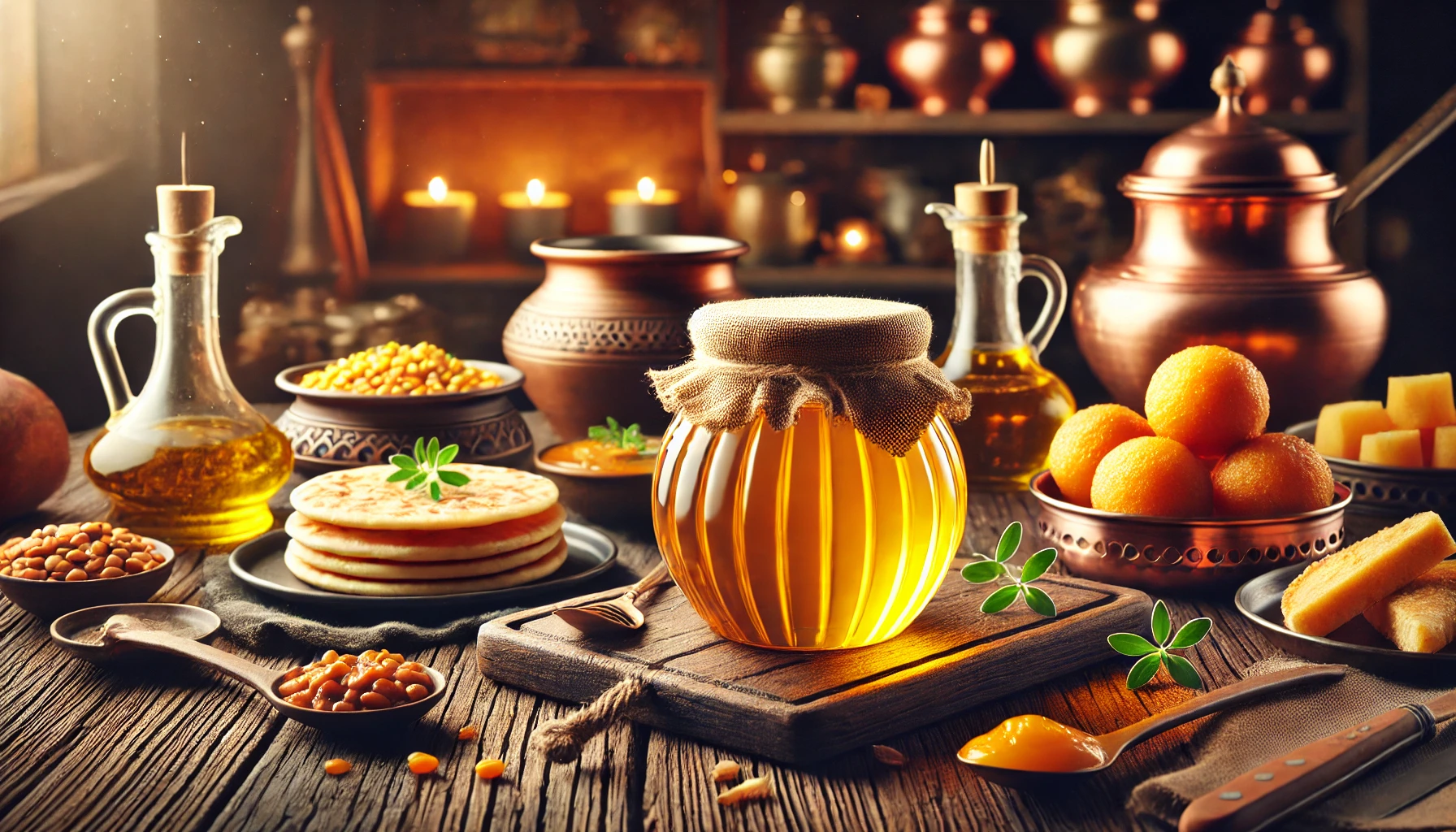
I’ve been searching for information like this for a while. Thanks for taking the time to put this together! Fantastic job covering this topic in such depth! I’ve been searching for information like this for a while. Your perspective on this topic is refreshing! This article is a treasure trove of information! Thanks for taking the time to put this together! This post is really informative and provides great insights!